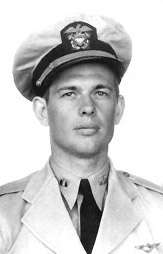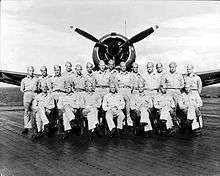Richard Halsey Best
| Richard Halsey Best | |
|---|---|
 | |
| Born |
March 24, 1910 Bayonne, New Jersey |
| Died |
October 28, 2001 (aged 91) Santa Monica, California |
| Allegiance |
|
| Service/branch |
|
| Years of service | 1928–1944 (16 Years) |
| Rank |
|
| Battles/wars |
World War II Pacific War |
| Awards |
Navy Cross Distinguished Flying Cross |
Lieutenant Commander Richard Halsey "Dick" Best, USN, (March 24, 1910 – October 28, 2001) was a dive-bomber pilot in the United States Navy, during World War II.
Early career (1928–1941)
Richard H. Best was appointed to the United States Naval Academy in 1928, and he graduated with honors in 1932. Following his graduation he served for two years aboard the light cruiser USS Richmond (CL-9). In 1934 he was transferred to the Naval Air Station Pensacola, Florida, as a naval aviation student. He completed his flight training in December 1935 and was assigned to Fighting Squadron Two (VF-2B) aboard the aircraft carrier USS Lexington (CV-2), flying the Grumman F2F. In June 1938, he was given the choice to either join a patrol squadron at Panama or Hawaii, or become a flight instructor at Pensacola. Best chose to go to Pensacola and was assigned to Training Squadron Five, which trained carrier aviation, aerobatics, aerial combat and gunnery, dive bombing, torpedo dropping, formation flying, and instrument flying. As instrument flying became a mandatory requirement, Best also trained the flight instructors.
On May 31, 1940, Best received orders to join Bombing Squadron Six (VB-6) aboard the aircraft carrier USS Enterprise (CV-6). Upon arrival at Naval Air Station North Island, California, on June 10, Best became Flight Officer (operations officer) of VB-6. Up to early 1942 Best advanced to Executive Officer and finally Commander of VB-6.[1]
In 1940 VB-6 was equipped with the Northrop BT-1 dive bomber, and converted in late 1941 to the Douglas SBD-2 Dauntless. In the spring of 1942 the SBD-3 replaced the SBD-2, being equipped with an uprated engine, armour, self-sealing fuel tanks and a better armament.[2]
World War II (1941–1944)
On December 7, 1941, the Enterprise was operating 330 km (150 mi) south of Pearl Harbor. At about 06:15 the carrier launched 18 SBDs to search ahead of the carrier, the Commander of the Enterprise Air Group, LtCdr. Howard L. Young, 12 planes of Scouting Squadron Six (VS-6) and five from VB-6, Best not being among them. Of VB-6, the crew of plane "6-B-3" was lost over Pearl Harbor.[3] On December 10 two pilots of VB-6 would sink the Japanese submarine I-70 at 23°45′N 155°35′W / 23.750°N 155.583°W.[4]

Best himself saw his first action on February 1, 1942. At dusk VB-6 attacked Japanese shipping off Kwajalein under his command; before noon he led eight SBDs from VB-6 and one from VS-6 to attack Taroa Island, Maloelap Atoll.[5]
On February 24, 1942 Best took part in the attack of Wake Island by the Enterprise Air Group, and on March 4 Marcus Island was attacked. After these raids Enterprise returned to Pearl Harbor and accompanied the USS Hornet (CV-8) during the "Doolittle Raid" in mid-April. Both carriers then sped to the south, but were too late to take part in the Battle of the Coral Sea. Both carriers and their sister ship USS Yorktown (CV-5) were then recalled to counter a new Japanese threat at Midway Islands. Enterprise and Hornet left Pearl Harbor on May 28, the hastily repaired Yorktown two days later to take part in what became known as the Battle of Midway, from 4 to June 6, 1942.[6]
After contact reports of Midway-based PBY Catalina patrol aircraft on the morning of June 4, 1942, Enterprise started to launch her air group starting on 07:06h. Under the overall command of the air group commander (CEAG) Lt.Cdr. Wade McClusky were 14 TBD-1 Devastator torpedo bombers of Torpedo Squadron 6 (VT-6), 34 SBDs of VB-6, the CEAG section, and VS-6, and ten F4F-4 Wildcat fighters of Fighting Squadron 6 (VF-6). However, the squadrons became separated and reached the Japanese independently. Only the dive bombers stayed together and reached the enemy by 09:55h. At about 10:22h the Enterprise dive bombers started to attack two Japanese carriers, which proved to be the Kaga, and the Akagi.
At this point, the attack became confused, as all 34 Dauntlesses started to attack Kaga, and none the Akagi. Obviously, Best expected to attack according to the U.S. dive bomber doctrine. This was that VB-6 would attack the nearer carrier (in that case Kaga) and VS-6 the one further away (here Akagi). The three-plane CEAG section was expected to attack last, as their planes were equipped with cameras to assess the damage later. However, evidently McClusky was not aware of this, having been a fighter pilot until becoming CEAG. Therefore McClusky began his dive on Kaga, being followed by VS-6, and Best's VB-6 was also attacking Kaga according to doctrine. Lieutenant Best noticed the error and broke off with his two wingmen to attack the Akagi.[7]

At 10:26h Best's three SBDs attacked the Akagi. The first bomb, dropped by Lt.(jg) Edwin John Kroeger, missed. The second bomb, aimed by Ens. Frederick Thomas Weber, landed in the water, near the stern. The force wave of that hit jammed the Akagi's rudder.[8] The last bomb, dropped by Best, punched though the flight deck and exploded in the upper hangar, in the middle of 18 Nakajima B5N2 planes, parked there. That hit doomed the Akagi.[9] Later that day, Lieutenant Best participated in the attack on the last remaining Japanese carrier - the Hiryu, possibly scoring one of the four hits.[10] Another very credible and more recent source states that on June 4, 1942, Best's gunner, James Francis Murray "saw the flash of their bomb through the smoke as it struck amidships forward of the island. Best is believed to be the first American pilot to successfully bomb two Japanese carriers in one day." [11] After the battle, Best was awarded the Navy Cross and the Distinguished Flying Cross. Considering this unique accomplishment, Admiral Thomas Moorer, and Vice-Admiral Bill Houser made a serious but failed effort to recommend Best for the Medal of Honor after his death in 2001. [12]
On the morning flight, Best had tested an oxygen bottle to be sure that it was not leaking caustic soda. Best's first inhalation was then filled with gas fumes. He snorted the gas fumes out, not thinking about it anymore. The next day Best began to cough up blood repeatedly. The flight surgeon found out that the gas fumes had activated latent tuberculosis. He entered the hospital at Pearl Harbor on June 24, 1942. After undergoing 32 months of treatment, Richard Best retired from the US Navy in 1944.[13]
Civil life (1944–2001)
After his retirement from the Navy Best moved to Santa Monica, California, where he lived for the rest of his life. After discharge from the hospital, Best worked in a small research division of the Douglas Aircraft Corporation. This division became part of the Rand Corporation in December 1948, where Best headed the security department until his retirement in March 1975.[14] He died in October 2001 and was buried at Arlington National Cemetery. Best was married and had a daughter - Barbara Ann Llewellyn and a son - Richard Halsey Best II.[15]
References
- ↑ Hernandez, Daniel V. (with Lt. CDR Richard H. Best, USN Ret.): SBD-3 Dauntless and the Battle of Midway. Valencia, Spain: Aeronaval Publishing, 2004, p. 7. ISBN 84-932963-0-9
- ↑ Bowers, Peter M. United States Navy Aircraft since 1911. Annapolis, MD: Naval Institute Press, 1990. pp. 183-184 and 397. ISBN 0-87021-792-5
- ↑ http://cv6.org/ship/logs/ph/org-am-19411207.htm
- ↑ http://cv6.org/ship/logs/ph/ela19411210.htm
- ↑ http://cv6.org/ship/logs/action19420201-vb6-1015.htm
- ↑ http://cv6.org/1942/midway/default.htm
- ↑ Robert J. Cressman: A Glorious Page in our History. The Battle of Midway 4-June 6, 1942. Pictoral Histories Publishing Co., Missoula 1990, pp. 101-102. ISBN 0-929521-40-4
- ↑ Jonathan Parshall, Anthony Tully: Shattered Sword: The Untold Story of the Battle of Midway, Washington 2005, p. 257. ISBN 978-1-57488-923-9
- ↑ Jonathan/Tully, pp. 241-242
- ↑ Parshall/Tully say that it is difficult to assess who hit Hiryu (p. 326).
- ↑ Moore, Stephen L., (2014) Pacific Payback, Published by Penguin Books, Random House, New York, p. 289
- ↑ Moore, Stephen L., (2014) Pacific Payback, Published by Penguin Books, Random House, New York, p. 355
- ↑ Gordon W. Prange: Miracle at Midway. Penguin Books, London/New York 1982, pp. 273-274. ISBN 0-14-006814-7; Best's battle account: http://www.immf-midway.com/narrative.html
- ↑ Hernandez, p. 7.
- ↑ http://www.arlingtoncemetery.net/rhbest.htm